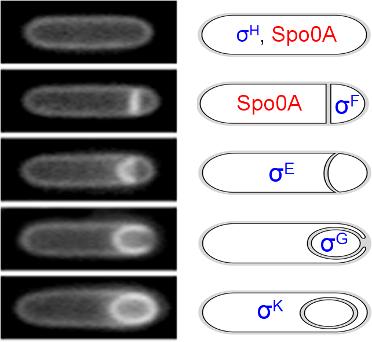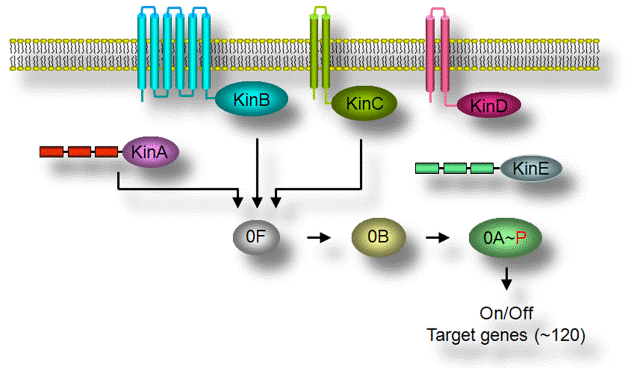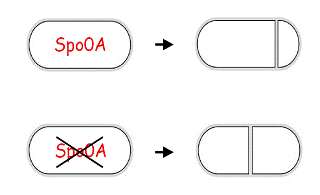Fujita Lab

Fujita Lab

Our research interests are how asymmetry is generated during development, and how gene expression is regulated temporally and spatially. The process of endospore formation (sporulation) in Bacillus subtilis, Gram-positive soil bacterium, is an ideal system in which to address these questions experimentally. The primary focus in our laboratory has been on an elegant signal transduction pathway to activate a transcription factor.

Fig. 1 Electron micrograph of B. subtilis
Growing Cell (Left); Sporulating Cell (Right)
Triggered by nutrient limitation, B. subtilis undergoes a switch from binary fission to asymmetric division, in which a division septum is laid down close to one of the cell poles (Fig.1). Polar septation divides the developing cell into two unequal-sized cellular compartments called the mother cell (the larger cell) and the forespore that follow dissimilar pathways of differentiation (Fig.2).

Fig. 2 Coupling of gene transcription and morphogenesis
The key to understanding the initiation of sporulation is to understanding the mechanism(s) of the signal transduction pathway. One striking feature of this signal transduction pathway is a complex phosphorelay to activate Spo0A, a transcription activator protein as a response regulator. Most response regulators in bacteria are phosphorylated directly by a cognate sensor kinase that carries out autophosphorylation on a histidine residue and then transfers the phosphoryl group to the aspartyl residue in the response regulator. Spo0A, in contrast, is indirectly phosphorylated by a multicomponent phosphorelay involving at least three kinases called KinA, KinB, and KinC. The kinases phosphorylate Spo0F, and the resulting Spo0F-P, in turn, transfers the phosphoryl group to Spo0B. Finally, Spo0B-P transfers the phosphoryl group to, and thereby activates, Spo0A (Fig.3).

Fig. 3 Multicomponent phosphorelay
Phosphorylated Spo0A activates the transcription of sporulation genes and triggers the asymmetric division (Fig.4).

Fig. 4 Spo0A, the master regulator for sporulation
However, it is still not clear how the upstream kinases are activated upon sporulation. Thus, a key challenge will be to determine the mechanism(s) by which the kinases become active. We plan to continue characterizing the signal transduction pathway for sporulation and to extend our analysis to identify the signaling molecule for triggering sporulation.
We utilize a broad array of approaches, including:
Masaya Fujita
Biology and Biochemistry Department
University of Houston
Houston, Texas 77204-5001
Office: HSC 430
Phone: (713)743-9479
Email: mfujita@uh.edu

